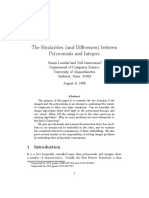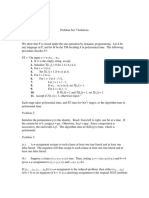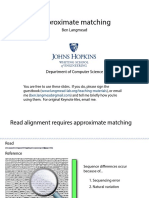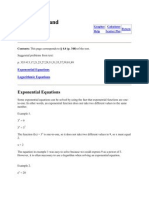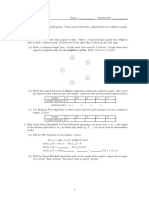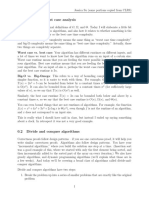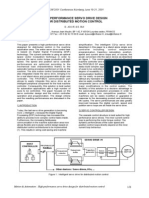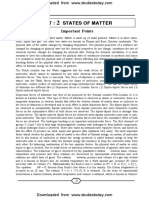0 ratings0% found this document useful (0 votes)
26 viewsPrinted by Wolfram Mathematica Student Edition
The document discusses using the real part of an argument to validate its correctness. It also mentions visualizing the variation of a function with k and Θ using a 3D plot. Plots are shown of the real parts of two functions, F and G, with respect to Θ and in 3D, to clearly illustrate the variation with k and Θ.
Uploaded by
Asanka AmarasingheCopyright
© © All Rights Reserved
Available Formats
Download as PDF, TXT or read online on Scribd
0 ratings0% found this document useful (0 votes)
26 viewsPrinted by Wolfram Mathematica Student Edition
The document discusses using the real part of an argument to validate its correctness. It also mentions visualizing the variation of a function with k and Θ using a 3D plot. Plots are shown of the real parts of two functions, F and G, with respect to Θ and in 3D, to clearly illustrate the variation with k and Θ.
Uploaded by
Asanka AmarasingheCopyright
© © All Rights Reserved
Available Formats
Download as PDF, TXT or read online on Scribd
You are on page 1/ 2
if you take real parts of both sides still our argument is
correct. So I used the real part. This should work for the Imaginary part
too. I even did a 3D plot to visualize clearly the variation with k
F k ,
: Sum 2 l
Plot Re F 1,
, ,
LegendreP l, Cos
BesselJ l , k
, l, 0, 6 ;
,
1.0
0.8
0.6
0.4
Plot3D Re F k,
, ,
, , k, 1, 3 , AxesLabel
Automatic
Printed by Wolfram Mathematica Student Edition
partial waves.nb
G k ,
: Exp
Plot Re G 1,
k Cos
, ,
,
1.0
0.9
0.8
0.7
0.6
Plot3D Re G k,
, ,
, , k, 1, 3 , AxesLabel
Automatic
Printed by Wolfram Mathematica Student Edition
You might also like
- LQG - LTR Controller Design Quanser Rotary Inverted PendulumNo ratings yetLQG - LTR Controller Design Quanser Rotary Inverted Pendulum6 pages
- Acta Mathematica Academiae Paedagogicae Ny´ıregyh´ aziensis: 2πix 2πi (k+2) xNo ratings yetActa Mathematica Academiae Paedagogicae Ny´ıregyh´ aziensis: 2πix 2πi (k+2) x31 pages
- Power-Law Fitting and Log-Log Graphs: 5.1 Dealing With Power LawsNo ratings yetPower-Law Fitting and Log-Log Graphs: 5.1 Dealing With Power Laws8 pages
- The Similarities and Differences Between Polynomials and IntegersNo ratings yetThe Similarities and Differences Between Polynomials and Integers23 pages
- 1.4 Asymptotic Notations and Their PropertiesNo ratings yet1.4 Asymptotic Notations and Their Properties8 pages
- VSLAM Tutorial CVPR14 A13 BundleAdjustment HandoutNo ratings yetVSLAM Tutorial CVPR14 A13 BundleAdjustment Handout7 pages
- Theory of Computation Homework: P Is Closed Under Star OperationNo ratings yetTheory of Computation Homework: P Is Closed Under Star Operation2 pages
- MANE 666: Fundamentals of Finite Element Methods Term Project ReportNo ratings yetMANE 666: Fundamentals of Finite Element Methods Term Project Report22 pages
- Solution Manual for Computer Algorithms: Introduction to Design and Analysis, 3/E 3rd Edition : 0201612445instant download100% (4)Solution Manual for Computer Algorithms: Introduction to Design and Analysis, 3/E 3rd Edition : 0201612445instant download33 pages
- MITIT 2025 Winter Editorials Advanced Round 1No ratings yetMITIT 2025 Winter Editorials Advanced Round 16 pages
- Parametric Equations of Conic Sections: Mun Chou, FongNo ratings yetParametric Equations of Conic Sections: Mun Chou, Fong8 pages
- Reference: Sections 3.1 and 3.2 Pre-Assignment: Complete Questions 1 and 2 Below, Read The "Why" Section, and Do Question 1 A) ofNo ratings yetReference: Sections 3.1 and 3.2 Pre-Assignment: Complete Questions 1 and 2 Below, Read The "Why" Section, and Do Question 1 A) of7 pages
- Free Field Theory As A String Theory?: Rajesh GopakumarNo ratings yetFree Field Theory As A String Theory?: Rajesh Gopakumar10 pages
- Problem Set 3 Solutions: 6.849: Geometric Folding Algorithms Fall 2012 - Prof. Erik DemaineNo ratings yetProblem Set 3 Solutions: 6.849: Geometric Folding Algorithms Fall 2012 - Prof. Erik Demaine4 pages
- Trigonometric Functions in The Unit CircleNo ratings yetTrigonometric Functions in The Unit Circle10 pages
- Csitnepal: UNIT:-1 Principles of Analyzing Algorithms and ProblemsNo ratings yetCsitnepal: UNIT:-1 Principles of Analyzing Algorithms and Problems83 pages
- USA TSTST 2018 Solutions: United States of America - TST Selection Test Evan ChenNo ratings yetUSA TSTST 2018 Solutions: United States of America - TST Selection Test Evan Chen17 pages
- Advanced Algorithms 2011. Exam QuestionsNo ratings yetAdvanced Algorithms 2011. Exam Questions4 pages
- New Zealand Maths Olympiad Committee Friday Test, Solutions Camp 2006No ratings yetNew Zealand Maths Olympiad Committee Friday Test, Solutions Camp 20063 pages
- A First Course in Modular Forms: Corrections To The Fourth PrintingNo ratings yetA First Course in Modular Forms: Corrections To The Fourth Printing5 pages
- Analyzing Code with Θ, O and Ω: 1 DefinitionsNo ratings yetAnalyzing Code with Θ, O and Ω: 1 Definitions18 pages
- CSCE 3110 Data Structures and Algorithms Assignment 2No ratings yetCSCE 3110 Data Structures and Algorithms Assignment 24 pages
- Chemical Engineering Computing Kyambogo University Lecture 7No ratings yetChemical Engineering Computing Kyambogo University Lecture 73 pages
- Solution Manual for Computer Algorithms: Introduction to Design and Analysis, 3/E 3rd Edition : 0201612445 - 2025 Scribd Download Full Chapters100% (7)Solution Manual for Computer Algorithms: Introduction to Design and Analysis, 3/E 3rd Edition : 0201612445 - 2025 Scribd Download Full Chapters34 pages
- Week 1 - sessions 1, 2 - Chapter 1 - Mathematical review, Recursion reviewNo ratings yetWeek 1 - sessions 1, 2 - Chapter 1 - Mathematical review, Recursion review85 pages
- Quadrature Signals: Complex, But Not Complicated: by Richard LyonsNo ratings yetQuadrature Signals: Complex, But Not Complicated: by Richard Lyons0 pages
- 0. Introduction to Approximation AlgorithmsNo ratings yet0. Introduction to Approximation Algorithms5 pages
- Printed by Wolfram Mathematica Student EditionNo ratings yetPrinted by Wolfram Mathematica Student Edition1 page
- Catuskoti: A Logical Treatment To Its Qualitative Properties and Implementation On Quantum Double Slit ExperimentNo ratings yetCatuskoti: A Logical Treatment To Its Qualitative Properties and Implementation On Quantum Double Slit Experiment7 pages
- A: Ndsolve F '' X Cosxfx Cfx, G '' X Cosxgx Cgx,F0 1, F ' 0 0, G0 0, G ' 0 1, F, G, X, 0, 2 Π ; Plot N Evaluate F 2 Π G ' 2 Π - A, C, 0, 5No ratings yetA: Ndsolve F '' X Cosxfx Cfx, G '' X Cosxgx Cgx,F0 1, F ' 0 0, G0 0, G ' 0 1, F, G, X, 0, 2 Π ; Plot N Evaluate F 2 Π G ' 2 Π - A, C, 0, 51 page
- AP Physics B Electrostatics Coulomb Law Test of TimingNo ratings yetAP Physics B Electrostatics Coulomb Law Test of Timing3 pages
- Trimcbcv Calculation Methods For A Dynamical Model of The Remus 100 AUVNo ratings yetTrimcbcv Calculation Methods For A Dynamical Model of The Remus 100 AUV56 pages
- Minimum Particle Size For Cyclone Dust SeparatorNo ratings yetMinimum Particle Size For Cyclone Dust Separator6 pages
- Unit: 2 States of Matter: Important PointsNo ratings yetUnit: 2 States of Matter: Important Points24 pages
- Basic Concept List: Elementary Math Midlevel MathNo ratings yetBasic Concept List: Elementary Math Midlevel Math7 pages
- Science Lab Lists 2018 High School With PricesNo ratings yetScience Lab Lists 2018 High School With Prices35 pages
- LEARNING TASK NO 2-Liquid, Solid, SolutionsNo ratings yetLEARNING TASK NO 2-Liquid, Solid, Solutions5 pages
- Robtics The Nightsky Observer's Guide Volume 2 - Lente & Zomer NLNo ratings yetRobtics The Nightsky Observer's Guide Volume 2 - Lente & Zomer NL3 pages
- 01 - Measurement, Uncertainty, and DeviationNo ratings yet01 - Measurement, Uncertainty, and Deviation9 pages
- Ions in Actions: Grade 9 Science - Laboratory Activity 1.1No ratings yetIons in Actions: Grade 9 Science - Laboratory Activity 1.13 pages






